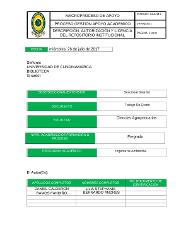| dc.description.abstract | El poliestireno es comúnmente considerado resistente a la degradación y por su corta vida útil se ha generado una acumulación excesiva de este material contaminante en el ambiente. En un análisis reportado por Wei-Min Wu (2015), comprobó que la larva de Tenebrio molitor era capaz de comer y digerir poliestireno. En esta propuesta se diseña un sistema experimental para la implementación de este descubrimiento en la biodegradación del poliestireno generado como residuo por el área de Educación y Recreación del Parque Recreativo y Zoológico Piscilago. Se midió la cantidad promedio de residuos de EPS generados, obteniendo un promedio de generación mensual de 3,12 Kg, posterior a esto 1800 larvas fueron colocadas durante 30 días en recipientes plásticos en seis tratamientos con 3 repeticiones, se implementaron 6 sustratos diferentes todos con bloques de EPS del mismo peso, cada una con 100 individuos dispuestos completamente al azar, con esto se demostró que al suministrar una fuente de agua como lo es la zanahoria se mejora la eficiencia del proceso de biodegradación. El presente estudio arrojo resultados mejores a los obtenidos por los científicos de la universidad de Stanford, mostrando un aumento significativo en todos los parámetros que se midieron y que se compararon. Donde el tratamiento 1 (A1Z1= EPS, sin sustrato, + 100 g zanahoria) fue el más efectivo a la hora de biodegradar el material, biodegradando un 62% del peso total del material y a su vez, fue el que tuvo mayor ganancia de biomasa, y menos cantidad de individuos que puparon, por otro lado el tratamiento menos efectivo fue el tratamiento 6 (A3Z2= EPS, harina de trigo, + sin zanahoria). Esta es una técnica biotecnológica novedosa que se presenta como una solución ambientalmente amigable a la problemática de los residuos plásticos en el ambiente, ya que estos reducen la vida útil de los rellenos sanitarios. ABSTRACT: Polystyrene is commonly considered resistant to degradation and due to its short useful life, an excessive accumulation of this polluting material has been generated in the environment. In an analysis reported by Wei-Min Wu (2015), it was found that the Tenebrio molitor larva was capable of eating and digesting polystyrene. In this proposal, an experimental system is designed for the implementation of this discovery in the biodegradation of polystyrene generated as waste by the Education and Recreation area of the Piscilago Recreational Park and Zoo. The average amount of EPS waste generated was measured, obtaining an average monthly generation of 3.12 Kg, after which 1800 larvae were placed for 30 days in plastic containers in six treatments with 3 repetitions, 6 different substrates were implemented, all with EPS blocks of the same weight, each with 100 individuals completely randomly arranged, with this it was shown that by supplying a source of water such as carrots, the efficiency of the biodegradation process is improved. The present study yielded better results than those obtained by scientists from Stanford University, showing a significant increase in all the parameters that were measured and compared. Where treatment 1 (A1Z1= EPS, without substrate, + 100 g carrot) was the most effective when it came to biodegrading the material, biodegrading 62% of the total weight of the material and, in turn, was the one with the highest biomass gain. , and fewer individuals that pupated, on the other hand, the least effective treatment was treatment 6 (A3Z2= EPS, wheat flour, + no carrot). This is a novel biotechnological technique that is presented as an environmentally friendly solution to the problem of plastic waste in the environment, since it reduces the useful life of landfills. | es_CO |

